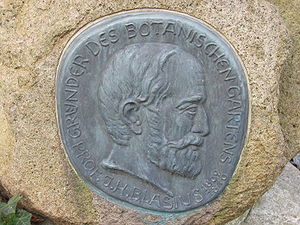
Johann Heinrich Blasius
Encyclopedia

Germany
Germany , officially the Federal Republic of Germany , is a federal parliamentary republic in Europe. The country consists of 16 states while the capital and largest city is Berlin. Germany covers an area of 357,021 km2 and has a largely temperate seasonal climate...
zoologist
Zoology
Zoology |zoölogy]]), is the branch of biology that relates to the animal kingdom, including the structure, embryology, evolution, classification, habits, and distribution of all animals, both living and extinct...
. In 1836, he was appointed as a professor at the Collegium Carolinum in Braunschweig
Braunschweig
Braunschweig , is a city of 247,400 people, located in the federal-state of Lower Saxony, Germany. It is located north of the Harz mountains at the farthest navigable point of the Oker river, which connects to the North Sea via the rivers Aller and Weser....
. In 1840, he founded the Botanischer Garten der Technischen Universität Braunschweig. In 1859 he was appointed as the director of the newly founded Naturhistorisches Museum (Braunschweig)
Naturhistorisches Museum (Braunschweig)
The Naturhistorische Museum Braunschweig is a zoology museum in Braunschweig.The museum was founded in 1754.The scientific collections include 3,000 mammal specimens, 50,000 bird specimens, 10,300 bird eggs, 4,000 skulls and skeletons, 1,000 fish , amphibians and reptile specimens...
and in 1866 also of the Herzog Anton Ulrich Museum
Herzog Anton Ulrich Museum
The Herzog Anton Ulrich Museum is an art museum in the German city of Braunschweig, Lower Saxony.Founded in 1754, the Herzog Anton Ulrich Museum is one of the oldest museums in Europe. It houses a collection of masters of Western art, including Cranach, Holbein, Van Dyck, Vermeer, Rubens, and...
.
He was the author of two books on vertebrates: Fauna der Wirbelthiere Deutschlands (1857), (Vertebrates
Vertebrate
Vertebrates are animals that are members of the subphylum Vertebrata . Vertebrates are the largest group of chordates, with currently about 58,000 species described. Vertebrates include the jawless fishes, bony fishes, sharks and rays, amphibians, reptiles, mammals, and birds...
of Europe), and Die wirbelthiere Europa's (1840) (with Alexander Keyserling
Alexander Keyserling
Alexander Friedrich Michael Lebrecht Nikolaus Arthur, Graf von Keyserling was a Baltic German geologist and paleontologist...
).
His son, August Wilhelm Heinrich Blasius
August Wilhelm Heinrich Blasius
August Wilhelm Heinrich Blasius was a German ornithologist.Blasius belonged to a family of scientists: his father was the ornithologist Johann Heinrich Blasius and his brother was the ornithologist Rudolf Heinrich Paul Blasius .In 1870 he became the director of the Museum of Brunswick, and in the...
, was an ornithologist.
External links
- The Darwin Correspondence Online Database
- BHL Digitised Die wirbelthiere Europa's

